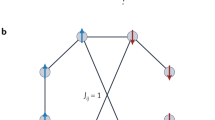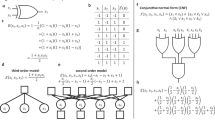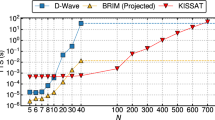Abstract
Ising machines are annealing processors that can solve combinatorial optimization problems via the physical evolution of the corresponding Ising graphs. Such machines are, however, typically restricted to solving problems with certain kinds of graph topology because the spin location and connections are fixed. Here, we report a universal Ising machine that supports arbitrary Ising graph topology with reasonable hardware resources using a coarse-grained compressed sparse row method to compress and store sparse Ising graph adjacency matrices. The approach, which we term interaction-centric storage, is suitable for any kind of Ising graph and reduces the memory scaling cost. We experimentally implement the Ising machine using compute-in-memory hardware based on a 40 nm resistive random-access memory arrays. We use the machine to solve max-cut and graph colouring problems, with the latter showing a 442–1,450 factor improvement in speed and 4.1 × 105–6.0 × 105 factor reduction in energy consumption compared to a general-purpose graphics processing unit. We also use our Ising machine to solve a realistic electronic design automation problem—multiple patterning lithography layout decomposition—with 390–65,550 times speedup compared to the integer linear programming algorithm on a typical central processing unit.
This is a preview of subscription content, access via your institution
Access options
Access Nature and 54 other Nature Portfolio journals
Get Nature+, our best-value online-access subscription
$32.99 / 30 days
cancel any time
Subscribe to this journal
Receive 12 digital issues and online access to articles
$119.00 per year
only $9.92 per issue
Buy this article
- Purchase on SpringerLink
- Instant access to full article PDF
Prices may be subject to local taxes which are calculated during checkout






Similar content being viewed by others
Data availability
Source data are available via Zenodo at https://doi.org/10.5281/zenodo.10686168 (ref. 41). Other data that support the findings of this study are available from the corresponding authors upon reasonable request.
Code availability
The core source code that implements the full-FPGA version of the UIM architecture is available via Zenodo at https://doi.org/10.5281/zenodo.10686168 (ref. 41). Other codes are available from the corresponding authors upon reasonable request.
References
Karp, R. M. Reducibility Among Combinatorial Problems (Springer, 2010).
Aadit, N. A. et al. Massively parallel probabilistic computing with sparse Ising machines. Nat. Electron. 5, 460–468 (2022).
Schuetz, M. J., Brubaker, J. K. & Katzgraber, H. G. Combinatorial optimization with physics-inspired graph neural networks. Nat. Mach. Intell. 4, 367–377 (2022).
Korte, B. H., Vygen, J., Korte, B. & Vygen, J. Combinatorial Optimization Vol. 1 (Springer, 2011).
Lin, S. & Kernighan, B. W. An effective heuristic algorithm for the traveling-salesman problem. Oper. Res. 21, 498–516 (1973).
Kokash, N. An Introduction to Heuristic Algorithms (Univ. Trento, 2005).
Tatsumura, K., Yamasaki, M. & Goto, H. Scaling out Ising machines using a multi-chip architecture for simulated bifurcation. Nat. Electron. 4, 208–217 (2021).
Mohseni, N., McMahon, P. L. & Byrnes, T. Ising machines as hardware solvers of combinatorial optimization problems. Nat. Rev. Phys. 4, 363–379 (2022).
Hu, F., Wang, B.-N., Wang, N. & Wang, C. Quantum machine learning with D-wave quantum computer. Quantum Eng. 1, e12 (2019).
Johnson, M. W. et al. Quantum annealing with manufactured spins. Nature 473, 194–198 (2011).
Inagaki, T. et al. A coherent Ising machine for 2000-node optimization problems. Science 354, 603–606 (2016).
Dutta, S. et al. An Ising Hamiltonian solver based on coupled stochastic phase-transition nano-oscillators. Nat. Electron. 4, 502–512 (2021).
Moy, W. et al. A 1,968-node coupled ring oscillator circuit for combinatorial optimization problem solving. Nat. Electron. 5, 310–317 (2022).
Takemoto, T., Hayashi, M., Yoshimura, C. & Yamaoka, M. 2.6 A 2 × 30k-spin multichip scalable annealing processor based on a processing-in-memory approach for solving large-scale combinatorial optimization problems. In IEEE International Solid-State Circuits Conference (ISSCC) 52–54 (IEEE, 2019).
Takemoto, T. et al. 4.6 a 144 kb annealing system composed of 9 × 16 kb annealing processor chips with scalable chip-to-chip connections for large-scale combinatorial optimization problems. In IEEE International Solid-State Circuits Conference (ISSCC) Vol. 64, 64–66 (IEEE, 2021).
Yamamoto, K. et al. 7.3 statica: a 512-spin 0.25 m-weight full-digital annealing processor with a near-memory all-spin-updates-at-once architecture for combinatorial optimization with complete spin-spin interactions. In IEEE International Solid-State Circuits Conference (ISSCC) 138–140 (IEEE, 2020).
Chou, J., Bramhavar, S., Ghosh, S. & Herzog, W. Analog coupled oscillator based weighted Ising machine. Sci. Rep. 9, 14786 (2019).
Su, Y., Kim, H. & Kim, B. CIM-spin: a scalable CMOS annealing processor with digital in-memory spin operators and register spins for combinatorial optimization problems. IEEE J. Solid-State Circuits 57, 2263–2273 (2022).
Su, Y., Mu, J., Kim, H. & Kim, B. A scalable CMOS Ising computer featuring sparse and reconfigurable spin interconnects for solving combinatorial optimization problems. IEEE J. Solid-State Circuits 57, 858–868 (2022).
Wang, T. & Roychowdhury, J. OIM: oscillator-based Ising machines for solving combinatorial optimisation problems. In Unconventional Computation and Natural Computation: 18th International Conference, UCNC 2019 Vol. 18, 232–256 (Springer International Publishing, 2019).
Wang, T., Wu, L. & Roychowdhury, J. New computational results and hardware prototypes for oscillator-based Ising machines. In Proc. 56th Design Automation Conference (DAC) 1–2 (ACM, 2019).
Tatsumura, K., Dixon, A. R. & Goto, H. FPGA-based simulated bifurcation machine. In Proc. International Conference on Field Programmable Logic and Applications (FPL) 59–66 (IEEE, 2019).
Yamamoto, K. et al. A time-division multiplexing Ising machine on FPGAs. In Proc. International Symposium on Highly Efficient Accelerators and Reconfigurable Technologies 1–6 (ACM, 2017).
Cook, C., Jin, W. & Tan, S. X.-D. GPU-based Ising computing for solving balanced min-cut graph partitioning problem. Preprint at https://arxiv.org/abs/1908.00210 (2019).
Cook, C., Zhao, H., Sato, T., Hiromoto, M. & Tan, S. X.-D. GPU-based Ising computing for solving max-cut combinatorial optimization problems. Integration 69, 335–344 (2019).
Verma, N. et al. In-memory computing: advances and prospects. IEEE Solid-State Circuits Mag. 11, 43–55 (2019).
Roy, K., Chakraborty, I., Ali, M., Ankit, A. & Agrawal, A. In-memory computing in emerging memory technologies for machine learning: an overview. In Proc. 57th Design Automation Conference (DAC) 1–6 (IEEE, 2020).
Yan, B. et al. Resistive memory-based in-memory computing: from device and large-scale integration system perspectives. Adv. Intell. Syst. 1, 1900068 (2019).
Sebastian, A., Le Gallo, M., Khaddam-Aljameh, R. & Eleftheriou, E. Memory devices and applications for in-memory computing. Nat. Nanotechnol. 15, 529–544 (2020).
Jiang, M., Shan, K., He, C. & Li, C. Efficient combinatorial optimization by quantum-inspired parallel annealing in analogue memristor crossbar. Nat. Commun. 14, 5927 (2023).
Barahona, F., Grötschel, M., Jünger, M. & Reinelt, G. An application of combinatorial optimization to statistical physics and circuit layout design. Oper. Res. 36, 493–513 (1988).
Goemans, M. Improved approximation algorithms for maximum cut and satisability problems using semidenite programming. J. Assoc. Comput. Mach. 42, 330–343 (1995).
Coudert, O. Exact coloring of real-life graphs is easy. In Proc. 34th Design Automation Conference (DAC) 121–126 (ACM, 1997).
Kahng, A. B., Park, C.-H., Xu, X. & Yao, H. Layout decomposition approaches for double patterning lithography. IEEE Trans. Comput.-Aided Des. Integr. Circuits Syst. 29, 939–952 (2010).
Ciesielski, M. J., Yang, S. & Perkowski, M. A. Multiple-valued Boolean minimization based on graph coloring. In Proc. International Conference on Computer Design: VLSI in Computers and Processors 262–263 (IEEE, 1989).
Smith, M. D., Ramsey, N. & Holloway, G. A generalized algorithm for graph-coloring register allocation. In Proc. ACM SIGPLAN Conference on Programming Language Design and Implementation 277–288 (ACM, 2004).
Johnson, D. S. & Trick, M. A. Cliques, Coloring, and Satisfiability: Second DIMACS Implementation Challenge Vol. 26 (American Mathematical Society, 1996).
Zhang, K., Qiu, M., Li, L. & Liu, X. Accelerating genetic algorithm for solving graph coloring problem based on CUDA architecture. In Bio-Inspired Computing—Theories and Applications 578–584 (Springer, 2014).
Ma, Y., Zeng, X. & Yu, B. Methodologies for layout decomposition and mask optimization: a systematic review. In Proc. International Conference on Very Large Scale Integration (VLSI-SoC) 1–6 (IEEE, 2017).
Li, W. et al. OpenMPL: an open-source layout decomposer. IEEE Trans. Comput.-Aided Des. Integr. Circuits Syst. 40, 2331–2344 (2020).
Yue, W. Scalable universal Ising machine enabled by interaction-centric storage and compute-in-memory technology. Zenodo https://doi.org/10.5281/zenodo.10686168 (2024).
Acknowledgements
This work was supported by the National Key R&D Programme of China (grant no. 2023YFB4502200), National Natural Science Foundation of China (grant nos 61925401, 92064004, 61927901, 8206100486, 92164302 and 92364102), Beijing Natural Science Foundation (grant no. L234026) and the 111 Project (grant no. B18001). Fund grant nos 2023YFB4502200, 61925401, 92064004, 92164302 and L234026 were awarded to Yuchao Yang. Fund grant no. 61927901 was awarded to R.H. Fund grant no. 8206100486 was awarded to Y.T. Fund grant no. 92364102 was awarded to B.Y.
Author information
Authors and Affiliations
Contributions
B.Y. and Yuchao Yang directed the research. W.Y. and B.Y. conceived the idea and planned the study. W.Y., Z.J. and B.Y. designed the RRAM chip. W.Y. and B.Y. designed the UIM architecture. W.Y. implemented the closed-loop CIM-based UIM system. Y.L. extended the UIM to the EDA application. T.Z., Yuxiang Yang, Z.Y., Y.W., W.B., K.Z., J.K., R.H. and Yuchao Yang developed the RRAM integration processes. T.Z., W.Y., Yuxiang Yang, Z.Y., Y.W. and Y.T. optimized the RRAM device. W.Y. and K.W. developed the video demonstration. K.W. optimized the testing platform. All authors reviewed and edited the paper.
Corresponding authors
Ethics declarations
Competing interests
The authors declare no competing interests.
Peer review
Peer review information
Nature Electronics thanks Bin Gao, Luke Theogarajan and Masanao Yamaoka for their contribution to the peer review of this work.
Additional information
Publisher’s note Springer Nature remains neutral with regard to jurisdictional claims in published maps and institutional affiliations.
Supplementary information
Supplementary Information
Supplementary Figs. 1–22, Notes 1–25 and Tables 1–12.
Supplementary Video 1
Computing process in the closed-loop system of the UIMe.
Rights and permissions
Springer Nature or its licensor (e.g. a society or other partner) holds exclusive rights to this article under a publishing agreement with the author(s) or other rightsholder(s); author self-archiving of the accepted manuscript version of this article is solely governed by the terms of such publishing agreement and applicable law.
About this article
Cite this article
Yue, W., Zhang, T., Jing, Z. et al. A scalable universal Ising machine based on interaction-centric storage and compute-in-memory. Nat Electron 7, 904–913 (2024). https://doi.org/10.1038/s41928-024-01228-7
Received:
Accepted:
Published:
Issue date:
DOI: https://doi.org/10.1038/s41928-024-01228-7
This article is cited by
-
Transforming memristor noises into computational innovations
Communications Materials (2025)



